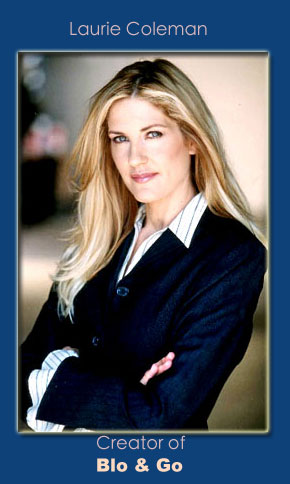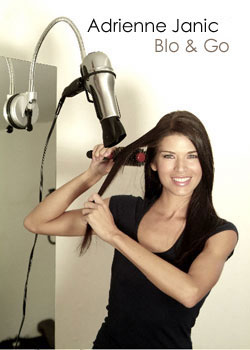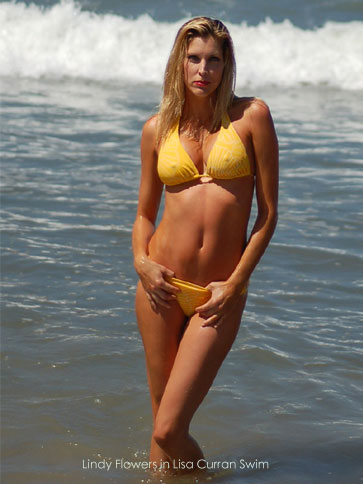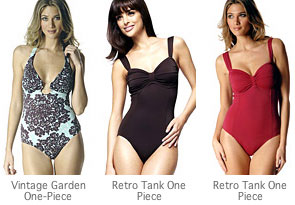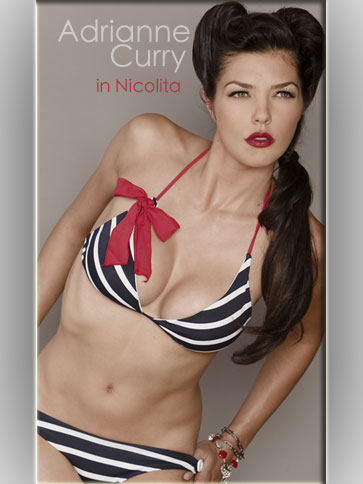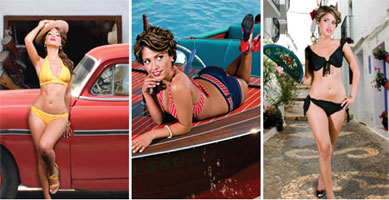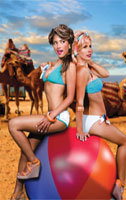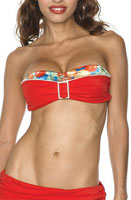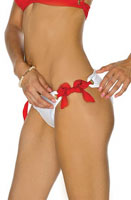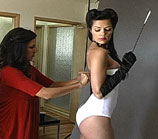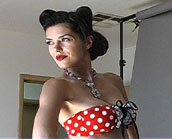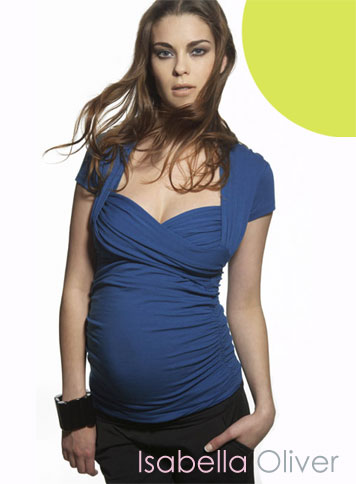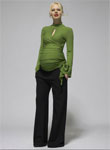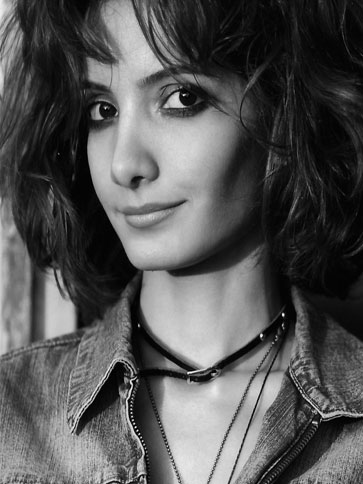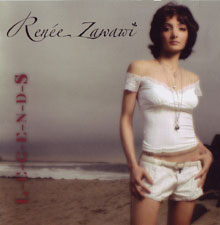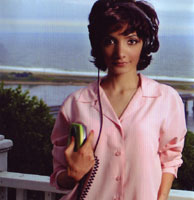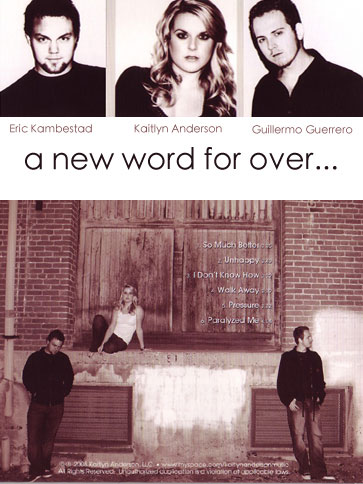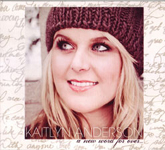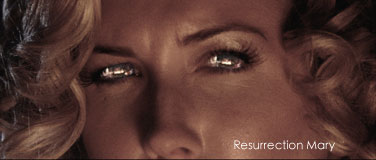|
Blo & Go, Changing the Way We Blow-Dry Our Hair – An Interview with Laurie Coleman
BLO & GO has already been featured on “Good Morning America,” “The Early Show,” and the “Today Show.” Countless celebrities are already in possession of this fabulous invention, and BLO & GO is now available for purchase on HSN. I recently interviewed Laurie Coleman, the inventor of BLO & GO. Laurie, who all is involved in the creation of this product? It’s funny because it’s definitely one of those ideas where you have necessity as the mother of invention. That’s really how the whole thing started. I would be getting ready to go out or go on an audition and you come out of the shower and you get your hair blown out. I would take a coat hanger and I would hook it over my door and I would put my hair dryer in it. I’d just sort of rig it up. And that way I’d have two hands because I was struggling with the brush and the hair dryer. I’d watched other women struggle with it, too. So if I could just get something that would hold my hair dryer above my head, I could replicate that fan blow-out. My friend Anthony Turk walked in and asked, “What are you doing?” I explained how difficult it was to hold the blow dryer and then add my round or flat brush and get my hair blown out. So he suggested we come up with something. We did a patent search and it came back that there wasn’t one for what we were trying to do. We weren’t exactly sure what it would look like. But that’s how it really started. We worked with an engineer and we came up with this. The thing that makes it so great is the suction cup allows you to put it on your mirror or window and that it’s up above your head. So when you’re sitting in the salon and they’re doing your hair, they’re up above you. And that’s really how the whole thing started, and now we sort of have a team together. We really persevered . . . and now we’ll be going on HSN. A lot of celebrities use this product, I understand. Yes, it really has been super positive. I think it’s because women get it immediately. When we started we were dealing with a lot of men, and they were kind of like, “Well . . . whatever. I don’t get it.” And then the second women would see it, it was just like major thumbs up. Let’s talk about the actual invention itself. What was the process to actually come up with something that’s workable? We worked with a couple of different people. The first time it came out, it was really complicated. The idea is that we really wanted it to be portable. So we had a couple of things we wanted. We wanted people to be able to use it up above or on a counter. I wanted it so it wouldn’t have to sit on your counter the whole time. You could just I’ve heard stories where getting a patent is very difficult. Did you guys run into any obstacle trying to get your patent? Yeah, it comes back a lot. Right now it’s passing. It costs a lot of money. You have to get a patent attorney, and then you have to go through legal steps through the patent office in D.C. But it’s just one of those things where you have to stay at it. There were a couple of other similar products earlier, but the problem with it was it was really big and heavy like a big microphone stand and it weighed a ton. It really wasn’t very practical. But ours is different. But it’s still a very slow process. What’s going to be your ultimate retail price on the Blo & Go, or have you not figured that out yet? We haven’t really figured that out yet because we’re not quite ready for retail. We’re very close. We’ve a really great box, but there are a lot of steps to go through with retail. You need to have a track record of sales. HSN will be really great for that. We’ve had good response with our website as well as going into the international market, especially Hispanic. We would like to move into retail, hopefully by fall. You said you can get it on the website. What’s the price for somebody to purchase it there? It’s $29.99 plus shipping and handling. We also are introducing a really great product line of hair products, which are additional add-on sales, as well. You can get this at www.bloandgo.com. Tell me about some of the other products you’re introducing. It’s a hair serum. It decreases the drying time in your hair. We’ve worked with a hair care line to develop this for us specifically. It also has just a little bit of illumination to it. You have just a little bit of shine. It doesn’t weigh the hair down. It doesn’t make it greasy. It just gives it a nice texture and a beautiful shine. That’s the only product we have now, but we’re probably going to develop a shampoo and a conditioner. We’re not quite there yet. That’s exciting. It’s like it’s taken a whole new turn. It is exciting! I never thought of myself as being an inventor and running a company, but strange things happen. Tell me a little about your background. Well, I’m actually a trained ballet dancer. And from that I moved into commercials and did a lot of runway modeling and a couple of small parts in things. I have a performing arts background. Actually, my entire family was in the performing arts in one way or another. I am married to a United States Senator. I have two wonderful kids. My son Jacob is going off to law school; and my daughter is just graduating and is going off to Notre Dame. It’s just one of those times in your life when you’re looking for something different. This really just fell into my lap. I was just fine and just using my coat hanger. Blo & Go has really just taken off, and it’s been a fun adventure. Let’s talk about the logistics of Blo & Go. Let’s say I take your Blo & Go and I put it on the mirror. What next? You put it on either a mirror or a window or your vanity. These are the three surfaces that it really works best on. And then you get it to the height that you want to use it. Then you take your blow dryer, feed it through the little cradle—it has a bungee cord that holds it in so it can’t fall out—and then you start blow-drying your hair a little bit . . . and then you start replicating that salon experience. I blow-dry my hair in sections. You can pop in on our website to see the models blow drying their hair. That’s it. It’s very simple. Everybody uses it a little differently, but basically it accomplishes the same purpose. I encourage everyone to try it because they’re going to love it. Once they start, they’ll be like, “Where has this been all my life?” To learn more about BLO & GO visit www.bloandgo.com. Interviewed by Kaylene Peoples |
Author: admin
Lisa Curran Swim – Designing Versatile Swimsuits
|
Lisa Curran Swim – Designing Versatile Swimsuits
Lisa, your swimsuits are fun and very figure flattering. How did you come up with such a variety of swimsuit styles? When I am designing, I always have a particular person in mind. Who is she? Is she in college? Is she a young mommy? Is she into fashion or more conservative? Then I What inspires your designs? Whatever I am feeling at the moment. At the moment, I am really into retro mod. What types of fabrics do you use for your cover-ups? What makes a practical cover-up? I use light cottons or a lighter version of my swimsuit material. I use something that will dry quickly. What is your design background (i.e. education)? I have a degree from FIT and University of Delaware. How long have you been designing? Eleven years. You’ve had a lot of success, you’ve graced several magazines, and you are among the favorite of a lot of celebrities. How do you continue to reinvent yourself so well with each new collection? It actually gets more difficult the more successful you become. But thank God I love what I do, so it comes pretty easy to me. How would you define your spring/summer swimsuit collection?
Do you have a favorite piece in your collection? I have a few favorites. I love the patent and the navy Lucite. What other types of garments do you design? I am starting to get into summer dresses. What are your price points? $160-$210. What would you say sets you apart from other designers? My fit. What obstacles if any did you encounter when starting your line? I encountered many obstacles. Money, production, working 24/7. It wasn’t easy, but I made it through it. I believed in my product, so I was determined. What was your highest high as a designer? My first Sports Illustrated swimsuit party, and going to the Golden Globes and meeting so many celebrities. Lisa Curran Swim is located in retail stores, and you can purchase her suits directly from her website www.lisacurranswim.com. Interviewed by Kaylene Peoples See the fashion editorial. Lisa Curran Swim is also featured in this issue’s “Summer 2008 Issue” video segment. |
Nicolita’s Nicole Saenz and her Vintage-Styled, Technicolored Swimsuits
|
Nicolita’s Nicole Saenz and her Vintage-Styled, Technicolored Swimsuits
In this issue, Agenda Magazine did a photo shoot featuring some of Nicolita’s designs modeled by TV personality Adrianne Curry, and I was able to experience her Nicole, we met each other over four years ago. I am delighted to see that you are doing so well. I always liked the uniqueness of your designs, and still wear that first suit you gave me back then. How would you say that your collections have evolved since you started designing swimsuits? Thank you so much. I, too, am thrilled with the success of Nicolita! Over the past six years I have maintained the uniqueness of my designs and, most importantly, my signature Nicolita branding. The nature of the fashion business is constantly evolving, and in order to be a successful designer, I must keep up with the ever-evolving industry. Nicolita designs are vintage glamour with modern flair. Our products capture the beauty of the past with today’s silhouettes. In my first couple selling seasons, buyers commented that my more intricate pieces wouldn’t sell; however, my sales didn’t reflect that pessimism. I was delighted to see that Nicolita’s vintage flare What type of woman defines Nicolita? The Nicolita customer is unique and flirtatious. She is classy but wants to show a little skin. How did you come up with the name Nicolita? This was my parents’ nickname for me. It means little Nicole. When I started thinking of a name for my company I found that the label for Nicole was taken, but Nicolita was unique and fit my personality. What are your price points? A Nicolita bikini is priced between $120.00 [and] $150.00. Do you only design swimsuits, or do you also do cover-ups, dresses, etc.? When I first started Nicolita, I designed customizable handbags. Then I saw the need What was your highest high as the designer for Nicolita, or as a designer in general? I have been blessed with many high moments during the process of starting Nicolita. One that comes to mind was making my very first sales call to Nordstrom and actually booking an appointment with the head swimwear buyer in San Francisco. I presented my designs, and within a week she placed an order. This was only six months after deciding that I wanted to do swimwear. Another that comes to mind was when I received a phone call from the swimwear buyer for Dillard, wanting to book an appointment in New York City. They wanted to see my showroom, and of course, it being so premature into my career, I had to get What was your lowest low (if you have had any lows at all)? Having your own business is constantly a roller coaster of high and low emotions. To pinpoint one low point is difficult to say. However, the common thread between every low experience is that it has built me back up stronger and better each time. Where do you see Nicolita in five years? Over the past six years I have seen a tremendous growth in the industry, and the reach on the Internet is so vast. Currently we just expanded to distribution in Europe, which I foresee to be a huge step for Nicolita. The next five years I want it to continue to be a leader in the swimwear industry. Eventually, I would like to expand into other markets. What was your biggest challenge in constantly creating new collections every season? My biggest challenge in creating a new collection each year is trying to figure out the story of where Nicolita is in her travels. There are so many places, that it’s hard to decide where she will go next. It is hard to narrow my creativity down, at the same time not get carried away with the endless possibilities. I enjoy visiting the countries first before I design the collection in order to get true inspiration. So far, Nicolita has traveled to Cuba, Morocco, Spain, and Italy. It was exciting to have you as part of Agenda Magazine‘s editorial shoot for the summer/swimsuit issue in which you dressed Adrianne Curry in suits that will be coming out next season. I liked how they had a vintage feel to them. What made you design in this style, and what inspired this new collection? The shoot was amazing, and Adrianne was so receptive to the vintage glamour that defines Nicolita. The suits fit her perfectly. Adrianne loved the Black and white one-piece with the low v-neck backside. She kept taking sexy pictures on her phone and sending them to her husband. She was great to work with. Some of the pieces that Adrianne wore at the photo shoot were mixed from Nicolita’s How long have you been designing, and what is your design background? I have been designing for Nicolita for almost seven years. I have my business degree from the University of Southern California, with an emphasis in entrepreneurship and marketing. All of my fashion sewing and designing background has been self-taught. I understand that you just did a shoot for Janice Dickinson recently. Would you care to share the details of that shoot and Nicolita’s specific involvement? Nicolita met with the Janice Dickenson Modeling Agency to find the new NICOLITA model. It was an interesting experience shooting a reality show and shooting for my 2009 Catalog. In addition to your website, where else can your swimsuits be purchased? Yes, besides shopping online at myNicolita.com, our products may be purchased online at our other web partners, Bestswimwear.com, Swimwearboutique.com, Razorreef.com, and BeachBliss.com. For boutique and department store locations where our product is sold, please visit mynicolita.com to search for a store near you. Any last words? Here’s your chance. Plug, plug away! We had a unique experience this year finding the new face for Nicolita. While we shot the Nicolita 2009 Catalog Collection, the Janice Dickenson Show documented the whole process for their TV show that will air on Oxygen and Bravo mid-August 2008. On the show, viewers will see how I narrowed down my search for the next Nicolita model. I had a wonderful time on the show. Janice and her models were great to work with. Visit www.mynicolita.com for more information. See the Nicolita Fashion editorial featuring Adrianne Curry. Interviewed by Kaylene Peoples |
Isabella Oliver – Maternity Wear without Compromising Style
|
Isabella Oliver – Maternity Wear without Compromising Style
Isabella Oliver’s collection is a favorite among celebrities, including Angelina Jolie, Jessica Alba, Jennifer Lopez, Minnie Driver, Amanda Peet, Tori Spelling, Marcia Cross, and Heidi Klum, just to name a few. Founders Vanessa Knox-Brien and Creative/Marketing Director Baukjen de Swaan Arons, formerly with Proctor and Gamble, initially launched Isabella Oliver in 2003. Vanessa was previously a head designer at Victoria’s Secret and head designer and Creative Director at Natori. Her designs have been recognized by Design and Lingerie critic awards and have been featured in popular television programs, such as “Sex and the City,” “Friends,” and “Will and Grace.” Interview with founders Vanessa Knox-Brien and Baukjen de Swaan: Your maternity line is a relatively new line, launched only five years ago (2003). What made you decide to design maternity clothing? When we [my husband Barrie and I] were pregnant with our first children (Isabella and Oliver), we could not find timeless, classic pieces. It doesn’t sound like a difficult What is your background, for example, education, training, etc.? Baukjen: I have a marketing and branding background, and this is the area I take responsibility for within Isabella Oliver, although we work closely together over all areas. Vanessa: My background is in design, lingerie specifically, and that is my core responsibility within Isabella Oliver. Did you encounter any specific challenges with the line? For instance, was sizing an issue? When we started, there were several hurdles that had to be overcome, for example, finding factories that are willing to work with a new company. Another challenge we had was to narrow down the designs we originally had in mind to a realistic size so that we had a collection that could be launched financially but also answer the needs of the modern pregnant woman, and together they would form a cohesive story. The line is very versatile. In your own words, can you describe your collection? It’s modern, effortless, chic yet comfortable. Anything that does not tick all those boxes does not go into the collection. Do you have a favorite piece? Vanessa: The Wrap Around Top in all its varieties. It’s so flattering and works throughout pregnancy and after. Baukjen: I have a different one every week but at the moment it is a style from the ’08-’09 Autumn/Winter collection, which is a silhouette which is clean, simple, timeless with a touch of sexiness. What are some of the fabrics you use? We focus on pregnancy-friendly fabrics that are soft on the skin, drape beautifully, grow with the pregnancy curves, and are easy care. So our fabrics include a variety of jerseys, tailored stretch wovens, and sweater knits. How would you say your line compares to other maternity lines?
Can your clothes be worn even after the pregnancy is over? Absolutely! What are some of your price points? They vary from $50 up to $850 for a wedding dress. I visited your website and was impressed how thorough the shopping experience was. You even have instructional videos to help women wear your clothes. How did you come up with such an amazing resource? We are an etailer which means we sell via the Internet and our catalog. We are continuously looking at how we can physically bridge the gap between ourselves and our customers. We give lots of advice, be it in videos, in our online magazine, on the product pages, and in the catalog to give as much information and tips to our customers. Even though our business is heavily dependent on technology, we always try to . . . “untech” and humanize our website. What inspires your designs? Lots of things. It can be a fabric, a neckline we saw in an old movie, a color of a wallpaper, the way a fabric moves and drapes, a photo hanging in someone’s living room. Inspiration is really limitless. What is your highest high as a designer?
Baukjen: The emails from customers, seeing a woman on the street wearing Isabella Oliver, the growth of the business. Have there been any lows? Of course. Delays in production, website issues, selling out and having frustrated customers. Anytime a situation is out of our control, it is frustrating, but we have learnt that the best way to deal with it is to be honest and communicate with our customers. What advice could you give pregnant women who are searching for clothes? Are there any tips to guide them to the right wardrobe? Be yourself. Don’t try to wear clothes that aren’t you. Invest in basic pieces with clean lines and neutral colors that you can dress up and down with accessories. Show off your curves. Don’t hide. What other kinds of items besides clothes do you manufacture/sell? At the moment we only sell clothing. However, we are branching out into other categories. Where do you see Isabella Oliver Maternity Clothing in five years? In the coming year we are launching our first collection for non-pregnant women, which will follow our design philosophy of timeless, modern, chic pieces that are comfortable and work every day. Also we are launching into a few other countries. Where will Isabella Oliver be in five years time? Hopefully, dressing women around the world who like our design concept! Any last words? Thank you for inviting us to participate. Isabella Oliver is a dream come true for us; but there’s a whole team behind it, so we’d like to thank them! Visit www.IsabellaOliver.com for more information. Interviewed by Kaylene Peoples |
Renée Zawawi’s L-E-G-E-N-D-S – How One Recording Artist Openly Shares Her Life in Her Music
|
Renée Zawawi’s L-E-G-E-N-D-S – How One Recording Artist Openly Shares Her Life in Her Music
When the first track “American Girrrl” came on, I immediately wanted to move. The beat is stirring and Renée Zawawi’s voice has a wispy, childlike quality, which is a nice contrast to the heavy dance groove. “‘American Girrrl’ is about being accepted in
The second track “The Wind Was Her Only Music” is a very visual track. The music is not the standard major chords that you hear in Western society. This song has a far-away quality, and the hook of this song is haunting and addicting. The Latin guitar tastefully adds to the track. Renée has a well-trained voice, exercising so much control, and she impresses me with her natural quarter toned vibrato. This song is about Renée’s experiences as a little girl, where she was dragged away from home by her abductors, and longed to see her family. Track 7 “Never Knew” starts out sexy with a Spanish feel, it alternates between mid-tempo and upbeat and is peppered with castanets once again showing Renée Zawawi’s uniqueness and her deliberate attempt at change. Renée pulls it off well. Every track inL-E-G-E-N-D-S encompasses Renée’s diversity. “I sang to release my soul and relieve the heartache of what I was going through.” Prevalent in L-E-G-E-N-D-S, Renée experiments with different and unique sounds. The beats are infectious and very synonymous with clubs and DJs. Renée’s voice is soothing and smooth—very reminiscent of Astrud Gilberto, in that she can hold a This album is unique, well-produced, creative, haunting, sexy . . . the adjectives are limitless. Renée has delivered a beautiful piece of eclectic work. I give this CD 4.5 stars. To keep updated on Renée Zawawi and L-E-G-E-N-D-S go towww.reneezawawi.com. Reviewed by Sean McKenzie |
Kaitlyn Anderson’s EP, A New Word For Over Climbs the Indie Pop/Rock Charts
|
Kaitlyn Anderson’s EP, A New Word For Over Climbs the Indie Pop/Rock Charts
“I take an idea, like pressure and think of ways I feel pressure in life. Running out of time for me was a big one. So I drew a clock and an hour glass symbolizing time… that turned into grains of sand and ticking clocks like I was on the clock and running out of time.” – Kaitlyn Anderson A New Word for Over is an easy blend of rock and pop. The first track is titled “So Much Better.” It has a catchy hook an upbeat groove, and Kaitlyn lives up to her songwriting. “I’m ever so much better without you.” She achieves the vibe that after a Kaitlyn Anderson moves me with her vocals, and most of the time she is spot on. I don’t really hear her influences (Bette Midler) in her voice, but that could be seen as a good thing. She has managed to cultivate her own style. The production on her EP is very professional and the sonic quality could fool anyone into thinking this was anything but an Indie project. Over all, I give this 3.5 stars out of 5 stars. Kudos to you, Kaitlyn and your team for a polished EP. The Personnel: Kaitlyn Anderson – Lead Vocals, Backgrounds, Writer and Co-Writer on all songs Eric Kambestad – Drum and Drum Arrangements Guillermo Guerrero – Guitars, Backgrounds, Musical Arrangements Visit www.myspace.com/kaitlynandersonmusic to learn more about Kaitlyn Anderson. Reviewed by Sean McKenzie |
Resurrection Mary’s Pamela Jean – A Young Leading Lady with a Promising Career
Resurrection Mary‘s Pamela Jean – A Young Leading Lady with a Promising Career
“What makes the story of Resurrection Mary so compelling to folklorists and other historians is the sheer number of documented credible eyewitness sightings of this very mysterious ghost, spanning decades.”
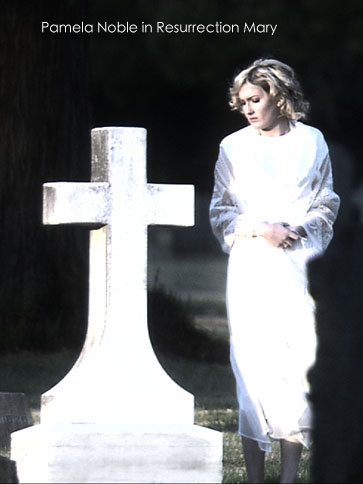 Resurrection Mary, directed by Sean Michael Beyer, is a film about a legendary ghost story about a high school student back in the 1930s. Pamela Jean (aka Pamela Noble), who plays opposite Kevin G. Schmidt, plays the character Mary. At just 18 years old, she made her on-screen debut in the movie’s title role. She has appeared in the short film Social Theory Revised, and has appeared in numerous music videos and commercials. Pamela’s role in this feature film certainly dictates that she has a promising career as a leading lady.
Resurrection Mary, directed by Sean Michael Beyer, is a film about a legendary ghost story about a high school student back in the 1930s. Pamela Jean (aka Pamela Noble), who plays opposite Kevin G. Schmidt, plays the character Mary. At just 18 years old, she made her on-screen debut in the movie’s title role. She has appeared in the short film Social Theory Revised, and has appeared in numerous music videos and commercials. Pamela’s role in this feature film certainly dictates that she has a promising career as a leading lady.
“Resurrection Mary manages to tell a story of ghosts and murder without falling into slasher movie clichés. Peppered with strong performances, Indie audiences who favor character development over gore will enjoy Resurrection Mary.“
—Michael Gavine, LAsThePlace.com—
So, Pamela, this is your first feature film. What is your background as an actress?
I started acting when I was five in television, did some modeling and commercials. When I was eight, I was with an agency and they ripped us off for $8,000.00. So I quit until I was about 13 and decided I wanted to get back into it. I started doing more singing than acting, and then at 14 that’s when I made the switch to doing what I wanted to do, acting. Singing is a lot harder industry to break into than acting. There’s a lot more competition. I do country music and they don’t want me because there are too many young blonde country artists out there right now.
That’s a really interesting statement you make. I’ve never heard that before, for someone to say that it’s harder to break into music than it is to break into acting.
I’ve been told that so many times that no country label is going to take me because there are too many blondes out there. I am not going to dye my hair. I went out on my first audition at eight, and all I did until I graduated from high school was do commercials and music videos.
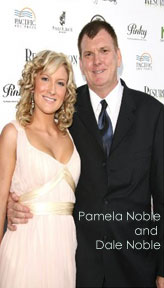 Your father, Dale Noble, is the Producer? What was it like working with your father on this film?
Your father, Dale Noble, is the Producer? What was it like working with your father on this film?
It was fun. I live out in Fontana, so I’m kind of far away. It was nice to have him around. If I ever needed to talk to somebody, he was right there. I had fun with it. I thought it was a great way to do my first film.
Being that he was the executive producer─and you said it was good to have him there with you─did it also help you with developing character for how you were going to perform in the movie, too?
Not really. When it came to film, I made my own decisions. To my dad and my agent, I always said I want to be in control of my acting career. I wanted to make the big decisions. For instance, when I was younger, I never wanted to be on a soap opera. I never wanted to be on Nickelodeon or a Disney show. There are a couple of actors that come out and they’re big, but some of them don’t do the kind of movies that I personally would be proud of. I want my career to be very broad. That’s one thing my dad knows off the bat. Anything I do in acting, I am going to make the decisions.
[Pertaining to Resurrection Mary], for example, my character Mary, was physically and verbally abused by her boyfriend, and he drank a lot. In the movie, you’ll see if anybody’s drinking around me, I was scared. And I would always fidget with my locket.
Those are always good signs of those films that have character development.
Yeah if you don’t have those, your character isn’t fully developed. Even though my character wasn’t assigned a last name, I gave her one. I gave her a birthday. You have to actually do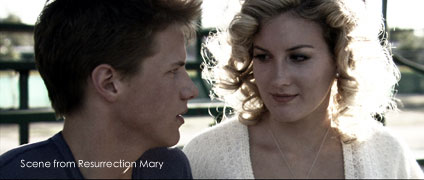 those things so you feel like you are her. For example, Mary is very prim and proper and I am a tomboy. [Someone even commented on how different I was from the character in the movie once they met me.]
those things so you feel like you are her. For example, Mary is very prim and proper and I am a tomboy. [Someone even commented on how different I was from the character in the movie once they met me.]
That makes your characters more 3-dimensional. IsResurrection Mary an Indie film?
Our film’s budget is higher than most Indie films, so they’re calling it something else. It was fully funded right from the beginning.
There are a lot of movies that are Indie films that were hugely funded. For example, Enemy at the Gate was an independent film. Right now there’s only Indie or studio films, but unfortunately sometimes when something’s labeled Indie, people automatically assume low budget. But obviously Resurrection Mary doesn’t really fit into that.
That’s what everyone thinks when they say Indie film. They think the budget is like $80,000.00, and everyone gets the wrong idea.
I guess they need to come up with a new label.
Pamela, where do you see yourself in five years?
My dad and I have talked about this. An up-and-coming director told me he wanted to do an action film with me, which is perfect for me. If I can be running around in shorts and be dirty and shooting guns, that’s perfect. Where do I sign up? He started writing one for me. We’re hoping that’s going to happen next. I’m hoping I can do a very dramatic love story. I always wanted to do a period piece. I always wanted to do some kind of musical because that’s where my passion is, too—it’s singing. I want my career to be very broad.
Being that you are a young actress who has made some very wise choices in your life already and in your career, which is probably going to play out very well in the future because of it, what advice would you give to someone who’s trying to also do the same thing you’re doing?
You have to work hard. Especially for the people in my film, I was basically the newcomer. Kevin Schmidt, who plays Jeff Pryce in the movie, has been in a lot of movies (The Butterfly Effect and Cheaper by the Dozen), and Kristen Herrera (Freedom Writers); and when you’re the lead role and one of the few people that no one really knows where you came from, you 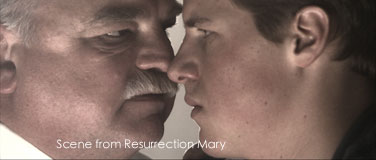 need to work twice as hard as anyone else. You need to show that you have a place to be in that movie. And that’s what I did. Every single day I was studying for this role, learning my lines. I had to learn a different way to talk. Especially in that kind of film, you have to be very articulate. You just have to work really hard and just be yourself. If you’re going to have the attitude that “I’m better than anyone else,” your career is not going to get far at all.
need to work twice as hard as anyone else. You need to show that you have a place to be in that movie. And that’s what I did. Every single day I was studying for this role, learning my lines. I had to learn a different way to talk. Especially in that kind of film, you have to be very articulate. You just have to work really hard and just be yourself. If you’re going to have the attitude that “I’m better than anyone else,” your career is not going to get far at all.
Is there anything else you’d like to add?
When people see the trailer to Resurrection Mary, they’re just going to think it’s a horror film, but it’s a lot more. At my premiere, people were coming up to me saying how they related to the character. People really need to come and see it, because it’s not just a horror film. It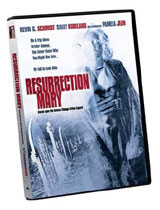 adds an element that is a lot different than the way most horror or thriller films are made.
adds an element that is a lot different than the way most horror or thriller films are made.
Resurrection Mary will be released on DVD August 26, 2008. To learn more about this film, visit www.resurrectionmarythemovie.com.
See the trailer of Resurrection Mary.
Interviewed by Kaylene Peoples
Dawn Westlake – Making Independent Filmmaking Look Easy
Dawn Westlake – Making Independent Filmmaking Look Easy
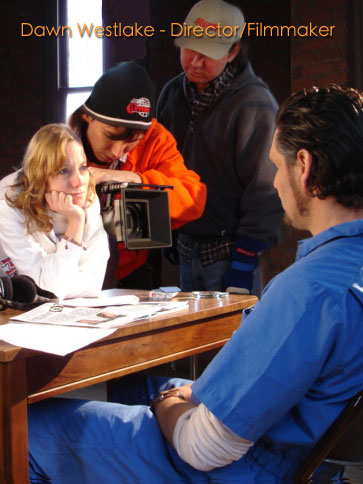 Dawn Westlake is a graduate from Northwestern University’s Radio-TV-Film program. She has been acting, writing, directing, and producing media and theater in Chicago, San Francisco, Los Angeles, Upstate NY, and Northern Portugal. She won the Mark of Excellence Award from the Society of Professional Journalists for a televised interview with former President Jimmy Carter in 1987 and NU’s prestigious Richter Scholarship for a thesis on TV3, Televisió de Catalunya in 1984. She was named a Platinum Filmmaker by Canon USA in 2002 and won an award for personal expression from JVC-Tokyo in 2005. Collectively, Dawn’s seven short films produced under her Ron de Caña Prods., Inc., banner have played on all seven continents and have won 38 international awards. She was named one of the “Top 100” short filmmakers in the world by Cultural Mall in 2008. And if that weren’t enough, Dawn is also fluent in Spanish and proficient in Portuguese and Italian.
Dawn Westlake is a graduate from Northwestern University’s Radio-TV-Film program. She has been acting, writing, directing, and producing media and theater in Chicago, San Francisco, Los Angeles, Upstate NY, and Northern Portugal. She won the Mark of Excellence Award from the Society of Professional Journalists for a televised interview with former President Jimmy Carter in 1987 and NU’s prestigious Richter Scholarship for a thesis on TV3, Televisió de Catalunya in 1984. She was named a Platinum Filmmaker by Canon USA in 2002 and won an award for personal expression from JVC-Tokyo in 2005. Collectively, Dawn’s seven short films produced under her Ron de Caña Prods., Inc., banner have played on all seven continents and have won 38 international awards. She was named one of the “Top 100” short filmmakers in the world by Cultural Mall in 2008. And if that weren’t enough, Dawn is also fluent in Spanish and proficient in Portuguese and Italian.
How did you get started in filmmaking?
As an actress I’ve been in SAG and AFTRA for about 20 years now and I basically got really frustrated from having no control. People treating you like, don’t let the door hit you in the bottom on the way out. That got old. So I started writing stuff and I thought a producer would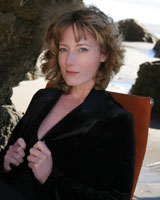 come along, and of course they never did. So then I started producing for myself. After a while, directing. I did my first film (Mini Driver Project) in Portugal.
come along, and of course they never did. So then I started producing for myself. After a while, directing. I did my first film (Mini Driver Project) in Portugal.
How is it that you were able to do your first film in Portugal?
I was trying to co-produce a feature film with Spain or some other Mediterranean country. I bought the rights to a very famous Spanish novel, and I was trying to get that done. I was knocking on doors and then knocking my head against the wall. And it wasn’t working out. So a friend of mine told me I needed to have a script and a tape of something I already produced, perhaps here in Portugal, and show that you can command a foreign crew. It didn’t make my co-production dreams come true.
How long does it take for you to write a screenplay?
I’m always writing in my head, so you could say it takes months and years, or if you want to talk about the time that I sit down, not that long—just a couple of days. When I feel like I’m 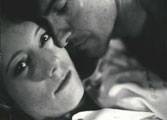 ready to shoot, I go to my crew, the Moser brothers. They do a lot of visual effects work, animation for really big shows and studios. When they have free time, that’s when we do my low budget stuff. They always tell me this is the stuff that has meaning. So they like being involved.
ready to shoot, I go to my crew, the Moser brothers. They do a lot of visual effects work, animation for really big shows and studios. When they have free time, that’s when we do my low budget stuff. They always tell me this is the stuff that has meaning. So they like being involved.
Are all of your films shorts?
Yes, they’re all shorts. The shortest one is eight minutes. That’s “The Life of Death” and the longest one is “God’s Good Pleasure.” That’s about 18-1⁄2 minutes.
What has been one of your biggest challenges when shooting your films?
Portugal was challenge because I was so far away from home in a different culture, but I’ve really been fortunate. I haven’t really had any big obstacles. I always work with people that I know I can trust. Also I rarely have ever cast. And what I mean by that is, I write for people I already know. In fact the first time I ever cast is for the most recent film. I cast “The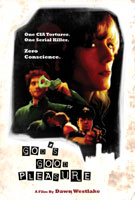 Grandpa.” I didn’t know anybody of that race in that age group. I couldn’t believe I didn’t know any 60 plus black actors. I put out an ad, and I found this wonderful gentleman, Warren Watkins, took him to lunch, and I didn’t even have him read lines. He was the part.
Grandpa.” I didn’t know anybody of that race in that age group. I couldn’t believe I didn’t know any 60 plus black actors. I put out an ad, and I found this wonderful gentleman, Warren Watkins, took him to lunch, and I didn’t even have him read lines. He was the part.
You seem to have an instinct.
I think I do have an instinct. Creepy sometimes. When I don’t follow my gut, that’s when I usually have problems.
You’re also an actress. Do you act in all of your movies?
Not all of them, but most of them.
What’s your background?
I was always acting as a kid. Then I thought that was not a very serious pursuit, so I went to Northwestern to be a broadcast journalist. And when I got out of school they were laying people off. It was the time of Laurence Tisch at CBS and the big strike at NBC, and there were no jobs. I hit rock bottom and I had always been this overachiever and here I was applying myself, pounding the pavement. People didn’t even want me to script bust or get 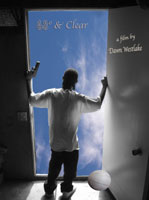 coffee. My then boyfriend, now husband was in my room at my parents’ house and saw all my trophies. He said, “I didn’t know you were an athlete.” I told him the trophies were for acting. He then said, “Why don’t you do that?” I told him it wasn’t a serious career, but he said a lot of people take it really seriously and they do well. So I went back to school and started studying at Second City in Chicago. I did some international commercials and industrials, then moved to San Francisco, did more work, and then came here.
coffee. My then boyfriend, now husband was in my room at my parents’ house and saw all my trophies. He said, “I didn’t know you were an athlete.” I told him the trophies were for acting. He then said, “Why don’t you do that?” I told him it wasn’t a serious career, but he said a lot of people take it really seriously and they do well. So I went back to school and started studying at Second City in Chicago. I did some international commercials and industrials, then moved to San Francisco, did more work, and then came here.
Was it hard finding an agent?
In Chicago not so much, because you can be multi-listed. You could have as many as 12 agents. So it can be exhausting making the rounds. You have a lot of people looking out for you. San Francisco I signed right away. Here . . . yeah, it was very difficult. I also ran into people whose ethics weren’t square with mine. That’s another reason I catapulted into setting my own schedule and taking charge.
As an actress, do you find it helps you with your directing skills?
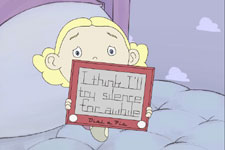 Oh, definitely. You try to put yourself in their position and try to encourage them to use things from life. Or if you see in their eyes that that might be too painful, you tell them about something in your own life.
Oh, definitely. You try to put yourself in their position and try to encourage them to use things from life. Or if you see in their eyes that that might be too painful, you tell them about something in your own life.
I like the fact that you don’t cast. I think you’re getting more authentic performances.
Absolutely! My father wrote and narrated the piece “The Life of Death.” And he’s probably one of my favorite actors. And he’s actually a material scientist. No acting bug ever hit him.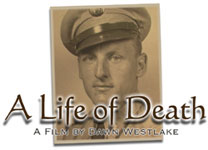 My editors said it was the easiest edit ever. He made his choices and he hit his mark the same every time. It was great working with my dad.
My editors said it was the easiest edit ever. He made his choices and he hit his mark the same every time. It was great working with my dad.
Highest High:
When I finish something and have it in the box with the packaging. That’s the greatest feeling. As far as festivals or awards . . . one thing that was pretty glamorous, I was invited to Taipei in 2004. I was up for what the Taiwanese consider their Oscar, called “Golden Horse.” I was flown there and put up in the Hyatt. One of the guys I competed with ended up winning our Oscar for Best Animated Short. A guy named Steven Hoban, the maker of “Ryan.” [I felt like I arrived.] But I love every festival I’m in. I’m starting to judge festivals now.
What medium do you shoot on, film or digital?
I call myself a filmmaker, but we always shoot mini DV. I’ve used the Canon XL, the Sony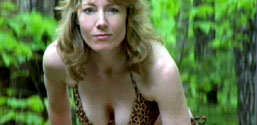 PD150, and the Panasonic DVX 100A. I used to edit on Premiere, but now I edit on Final Cut Pro.
PD150, and the Panasonic DVX 100A. I used to edit on Premiere, but now I edit on Final Cut Pro.
Do you edit your own films?
I’ve not edited my own movies, but I have this hobby doing all these viral vids for revver.com and YouTube.com and those I edit myself.
Lowest Low:
The first film in Portugal. There was this scene that was a health club which we turned into a restaurant that we had to shoot three [separate] times. I ended up making the film, but it took three times. It was either a sound problem or a lighting problem, or all-the-actors-were-fast-asleep problem because it was 4:00 in the morning. I had to beg the manager of the health club three times to let us shoot the scene over.
As an actress, how do you wear both hats?
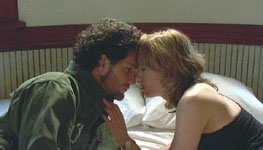 I have to tip my hat to the Moser brothers and their directing talents. I have a definite way that I want the film to look. I have a definite vision and that all gets explained beforehand. We have a lot of meetings and sometimes storyboards. So when it’s my turn to get in front of the camera, they’re really [good]. It’s all in the preparation. The more you prepare the more relaxed you can be when it’s time to act.
I have to tip my hat to the Moser brothers and their directing talents. I have a definite way that I want the film to look. I have a definite vision and that all gets explained beforehand. We have a lot of meetings and sometimes storyboards. So when it’s my turn to get in front of the camera, they’re really [good]. It’s all in the preparation. The more you prepare the more relaxed you can be when it’s time to act.
What advice would you give to an aspiring filmmaker?
Just do it. First of all, I don’t think I’m someone who really can give advice because I just think we all make our own paths and do our own things. You might be related to Spielberg, and that’s going to help you . . . . Don’t steal. Be ethical so you can sleep at night. And do get a good sleep at night so you’re not crabby at people. Otherwise, I don’t have advice other than just do it. There’s nothing stopping you.
To learn more about Dawn Westlake, visit her websites atwww.Filmbaby.com/films/2412, www.Rondecana.com, andwww.Dawnwestlake.com.
Interviewed by Kaylene Peoples
Watch the (video) interview with Dawn where she talks about her short films in detail.
Justin Chon—Climbing the Hollywood Ladder One Role at a Time
Justin Chon—Climbing the Hollywood Ladder One Role at a Time
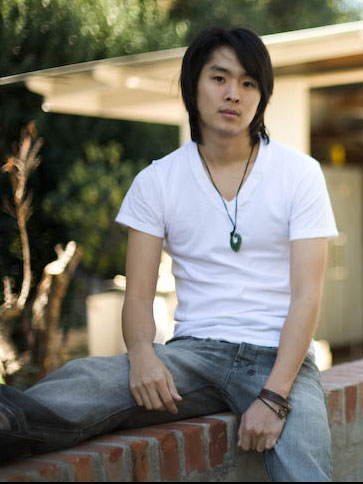 Justin Chon has been acting for six years and has already appeared in countless television shows. He got his first part in television after acting for only two years. He played Tony in the Nickelodeon series “Just Jordan” for two years and appeared in 14 episodes. He also appeared in several other television shows including “The O.C.,” “Wendy Wu: Homecoming Warrior,” and the horror film Hack. Justin Chon opens August 22, in a starring role with Harrison Ford, Sean Penn, Ray Liotta, and Ashley Judd in the Weinstein Company/MGM film, Crossing Over. The film, reminiscent of Crash or Babble, has six intersecting story lines, one of which Justin carries. Chon can also be seen in the upcoming films Balls Out: The Gary Houseman Story with Sean William Scott and Twilight with Kristen Stewart, based on Stephanie Meyer’s book Twilight, coming out this year.
Justin Chon has been acting for six years and has already appeared in countless television shows. He got his first part in television after acting for only two years. He played Tony in the Nickelodeon series “Just Jordan” for two years and appeared in 14 episodes. He also appeared in several other television shows including “The O.C.,” “Wendy Wu: Homecoming Warrior,” and the horror film Hack. Justin Chon opens August 22, in a starring role with Harrison Ford, Sean Penn, Ray Liotta, and Ashley Judd in the Weinstein Company/MGM film, Crossing Over. The film, reminiscent of Crash or Babble, has six intersecting story lines, one of which Justin carries. Chon can also be seen in the upcoming films Balls Out: The Gary Houseman Story with Sean William Scott and Twilight with Kristen Stewart, based on Stephanie Meyer’s book Twilight, coming out this year.
How did you get started acting?
My dad was an actor in South Korea. When I was young, I used to watch his black and white films. I’ve always been interested in acting and entertainment and stuff, but it wasn’t until I had to decide what I was going to do as a profession that I decided to try out acting. I took a few acting classes and decided that it’s something I really enjoyed, so I started to pursue it.
Do you think that the fact that your father was a well-known actor helped you?
Yeah, and what’s really helped is how my parents raised me. It was an extremely artistic household. My mom was a pianist. So she had me playing a bunch of different instruments since I was really young. I played the piano, violin, and the guitar. I was in the high school marching band. We’d watch movies my dad would enjoy and we’d talk about them. And my mom put me in art classes. So we were always [immersed] in the arts. I think that’s really helped me in terms of my acting career. But I didn’t take any acting classes until I got older.
You’re in quite a few movies coming out.
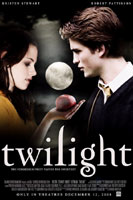 Yeah, I’m in this movie called Twilight, based on the Stephanie Meyer book called Twilight. I play a character called Eric Yorkie, and he’s just this sort of a geeky chess type guy and sort of really over-eager, overachiever. Another movie coming out is with Sean William Scott, and that’s called Balls Out: The Gary Houseman Story, and it’s more of a comedy. I play this guy named Joe Chang, and I’m on the tennis team. They call me the scrapper from the Far East. And I have a movie coming out in August called Crossing Over, starring Sean Penn, Harrison Ford, Ray Liotta, and Ashley Judd, that deals with immigration. There are a lot of different scenarios played out in the movie. There are green card issues, deportation, naturalization. It’s going to be interesting.
Yeah, I’m in this movie called Twilight, based on the Stephanie Meyer book called Twilight. I play a character called Eric Yorkie, and he’s just this sort of a geeky chess type guy and sort of really over-eager, overachiever. Another movie coming out is with Sean William Scott, and that’s called Balls Out: The Gary Houseman Story, and it’s more of a comedy. I play this guy named Joe Chang, and I’m on the tennis team. They call me the scrapper from the Far East. And I have a movie coming out in August called Crossing Over, starring Sean Penn, Harrison Ford, Ray Liotta, and Ashley Judd, that deals with immigration. There are a lot of different scenarios played out in the movie. There are green card issues, deportation, naturalization. It’s going to be interesting.
Would you say you’ve ever had any challenging roles?
Crossing Over is the most challenging it’s gotten. I have an accent, and I play a character that’s sort of like me, but not really. I’m dealing with material that’s somewhat familiar, but not. It’s a huge mixture of things that made it kind of difficult.
How long did it take you to shoot the movie?
My shooting schedule was about 2-3 weeks. There are a bunch of different story lines.
A lot of people try their hand at acting. They really pursue it really hard, but never quite make it. But you have in what seems like a short period of time. Would you like to share some of the things that you did to help you get past some of the barriers that other people can’t seem to get past?
The thing that I’ve done that has helped my career as well as helped me to excel has been to work really hard. It is just a lot of hard work. Especially being ethnic and a minority, I feel that I just have to try harder than everybody else to compete, also, continue to train. I don’t stop training. I’m always working on material whether I’m shooting or not. You have to have real tenacity and not care what people think. I think people worry [too much] about what people think. And you shouldn’t because it’s your career and it’s your life. And you should take control of your own situation. A lot of people play the blame game. But I try not to think about outside factors and just concentrate on what I’m doing to make it the best I can. And I feel like that’s gotten me to be better than a lot of other people.
Has your father helped you any, like with your style?
He doesn’t really tell me anything like techniques. He just tells me just to make it real, make it natural. Don’t act. Make it like it’s really happening. And that’s a pretty general note, but it’s a hard thing to do. He’s always saying, you got to make it real, just don’t fake anything.
So your family’s been very supportive.
At first they were a little skeptical because until a few years ago you didn’t see that many Asians on film except martial arts people. They were skeptical that it would be hard to make a living doing it. But once I started booking jobs, they started having a little bit more faith for the whole career aspect of it.
So being a young, good-looking, well-known actor, do you have any problem with young ladies throwing themselves at you?
Not really. I don’t think I’m that smooth. If there’s a really cute girl, or hot girl, I get really shy.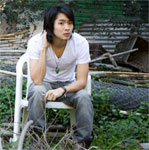 I really clam up. I don’t know in that department if it’s really helped me.
I really clam up. I don’t know in that department if it’s really helped me.
So what would a young lady have to do to win your heart?
I think just be upfront, truthful, and real. Down to earth and up for anything. Like let’s go hiking at midnight and drive up to San Bernardino.
So you like somebody who’s adventurous.
Recently I just went to Alaska with no plans. It would be nice to find someone who is adventurous as I am.
Highest High:
The specific breakthroughs I got in terms of acting. When I first started, it was really hard for me to express emotions and to just be really open about things. I always had this dumb smile on my face all the time. The highest high was when I was able to let that go. I was in an acting class and they gave us an exercise and I was able to just let it go. Everything just started coming out. Not forcefully, just naturally. I felt like I was doing what I was supposed to be doing.
Lowest Low:
There have been a lot of lows. Certain parts I had to do. There were a few parts that I wasn’t into that I had to do. There’s a lot of compromising your artistic values for your career. Sometimes you just have to do that. And there’s no shame in it. If no one knows who you are, you’re not going to get hired for bigger things.
Now that you’ve been around for a while, do you feel like you’re compromising a lot less?
No. I don’t think it ever ends. I think there are always bigger and better things out there. There are always people telling you to do something opposite what your heart tells you to do. I don’t think that goes away. But you compromise, unless you want to starve.
Because of the whole Indie filmmaking thing now, a lot of actors create their own scripts and even go out and make their own movies. Do you have any aspirations to do that?
I definitely do. I bought a really nice HD camera, a Panasonic HVX. I got this adapter for 35 mm lenses, got rails and everything. And I’m learning Final Cut Pro. If I have to do things,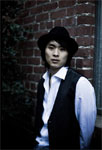 just to do them, at the end of the day I can do something for myself. I’ll get my friends and do something that’s artistic.
just to do them, at the end of the day I can do something for myself. I’ll get my friends and do something that’s artistic.
What kinds of roles would be the perfect role for you as an actor?
I really just like simple, kitchen-sink drama. I like movies that have strong relationships. It doesn’t have to be complicated crime thrillers. I like basic stuff that touches on the human condition—why we are the way we are. When it’s for me, I love to explore those kinds of things because it really gets somewhat introspective. You’ve got to look at yourself, too, and why you do things and try to make logic out of your life.
Let’s take, for example, someone like Bai Ling. She’s huge in China. Do you feel like you have a bigger following in South Korea than you have here?
I think right now I have no following in South Korea. I think that because most of the movies I’ve done have not come out yet. I’m relatively an unknown. Nobody knows who I am. There are a few things that might go through that might involve me with South Korean actors. If that were to happen, then, yes, I think it could grow. But I’m American. I grew up in Orange County. Whether that happens or not, that’s just fate, I guess. But I’m not pushing for it.
Where do you see yourself in five years?
I don’t know because if you would have asked me that question five years ago, I would not say that I’d be here.
Where would you like to see yourself?
I would like to see myself really doing projects that I enjoy, love, and believe in, working with fellow actors that are amazing and working with directors that have clear-cut visions and I am excited about their work. That’s all I ask for.
What would be your dream film that you could star in?
Nick Cassavetes and some Indie movie with no form or structure, or a David Lynch film where you’re just going for the ride and you can’t plan anything. Because a lot of movies are so predictable, with those two directors you would have no idea [what’s going to happen] when you show up on set. Every day would be like, okay, what are we doing?
Do you have an all-time favorite movie?
Yes, directed by Clint Eastwood, A Perfect World. Kevin Costner starred in it. I watched it in fifth grade, and I think it was the first movie that I got emotional—I cried. It was at summer camp in Big Bear—just the fact that a movie can touch you when you’re young. It just made a huge impact on me. It’s a testament to his directing.
To learn more about Justin and his upcoming films, visit his website at www.Justinchon.com.
Interviewed by Kaylene Peoples
Adrianne Curry – Top Model, Television Personality—Next Stop . . . Author!
Adrianne Curry – Top Model, Television Personality—Next Stop . . . Author!
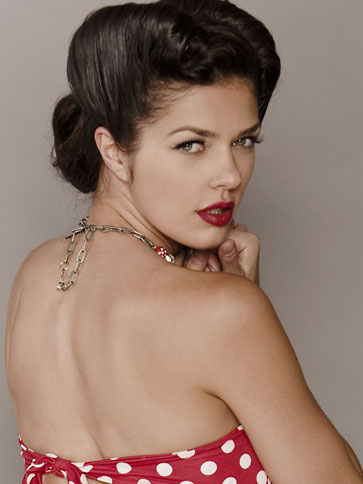 Adrianne Curry was the first winner of “America’s Next Top Model.” After one year she went on to star in the television reality show “The Surreal Life,” where she met her husband, former Brady Bunch cast member Peter Brady. Their union spun off to the highest rated VH-1 show “My Fair Brady.” Adrianne appeared on such television sitcoms as ABC‘s “Hot Properties” and UPN’s “Half and Half,” among others. She has taken on the big screen as well, in films such as Worlds Apartand Fallen Angels. Her modeling career has extended to include campaigns and runway shows for Famous Stars and Straps, Beverly Hills Choppers, Jaime by Jaime Presley, Cuffz by Linz, and Ed Hardy, to name a few. Adrianne has landed pictorials in Marie Claire, Sync, and Maxim, where she also made the prestigious “Maxim Hot 100” list of the world’s most beautiful women. She’s even writing a book.
Adrianne Curry was the first winner of “America’s Next Top Model.” After one year she went on to star in the television reality show “The Surreal Life,” where she met her husband, former Brady Bunch cast member Peter Brady. Their union spun off to the highest rated VH-1 show “My Fair Brady.” Adrianne appeared on such television sitcoms as ABC‘s “Hot Properties” and UPN’s “Half and Half,” among others. She has taken on the big screen as well, in films such as Worlds Apartand Fallen Angels. Her modeling career has extended to include campaigns and runway shows for Famous Stars and Straps, Beverly Hills Choppers, Jaime by Jaime Presley, Cuffz by Linz, and Ed Hardy, to name a few. Adrianne has landed pictorials in Marie Claire, Sync, and Maxim, where she also made the prestigious “Maxim Hot 100” list of the world’s most beautiful women. She’s even writing a book.
I visited Adrianne at her South Bay home, where she and her husband were still in the process of decorating. Her two cats hung around, occasionally scrapping as we chatted about her career. Adrianne shared with me very candidly what she’s been up to since “Top Model.”
I followed “America’s Next Top Model (ANTM)” so I kind of know how you got your start. Why don’t you enlighten our readers on what you’ve been doing since you won.
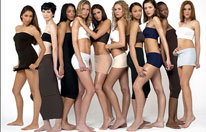 Since I won in 2003, I’ve been keeping pretty busy with reality television . . . and some modeling here and there.
Since I won in 2003, I’ve been keeping pretty busy with reality television . . . and some modeling here and there.
What was it like to win ANTM?
Winning “Top Model” for me was absolutely life-changing. I don’t know how to describe it. I had a life that was kind of almost living in hopelessness to having hope in my life. It took a while to get things going [after my win]. I got shipped off to Europe and traveled the world. I got put with an agency, [which] wasn’t a fan of the show [and I was] in a two-year deal, so I had to fight through that. [As a result I went on “The Surreal Life”] and started my television career. I met my husband Christopher Knight on that show. But that’s okay because at least I didn’t meet my husband on one of those loser dating shows. I’d walk in and say, “You’re going to make your decision now! Either you’re gonna come after me or I’m leaving, ‘cause I am not going to be your whore. Sorry Guy.” She laughs.
“The Surreal Life” branched off to three seasons so far of “My Fair Brady.” We’re one of VH1’s highest rated shows. Did celebrity paranormal project. I did a cameo in a few shows. I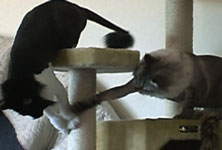 was on “Dirt” with Courtney Cox, “Hot Properties,” which used to be on ABC. Right now I am in the middle of writing a book and really close to closing a show deal to start producing and creating my own shows.
was on “Dirt” with Courtney Cox, “Hot Properties,” which used to be on ABC. Right now I am in the middle of writing a book and really close to closing a show deal to start producing and creating my own shows.
Tell me about your book.
It’s basically about the story of my life. I had a really troubled youth, huge drug and self-esteem problems. I was into self-mutilation. I’m really opening the floodgates, and I’m hoping that I’ll be able to help other people that are going through the same thing. I feel confident in writing it because even though it’s a dark story, it has an amazing ending. So it will uplift at the end. But it’s taken a toll on me. You get into really heavy stuff. There are things I hadn’t really talked about with my friends. I just recently called them up to tell them I was writing a book [and what it was about] and there was just this stunned silence. After the silence the normal response was, “Yeah, now that you say that, I could see that was probably happening with you. I didn’t even think it through. But now that I’m older, it makes sense.”
One year I went to school as Marilyn Manson, and I cut myself all up just like he used to. And everyone thought [my costume looked so real] and they jabbed me in these cuts and I would react “ough!” It was crazy. Who does that? Me. (Laughs). So I’m writing a book about it.
If you’re doing it, so are other people.
I know. Self-mutilation is a big problem. The problem is it feeds you temporary relief. It’s  really strange. When you’re feeling a lot of pain inside, you cut yourself. It’s like punishing yourself to feel better, and it’s not a good thing. It can come in all forms—people who verbally beat themselves up to people who physically beat themselves up.
really strange. When you’re feeling a lot of pain inside, you cut yourself. It’s like punishing yourself to feel better, and it’s not a good thing. It can come in all forms—people who verbally beat themselves up to people who physically beat themselves up.
You’re going to help a lot of young people. As one of the top bloggers on Myspace, you already have an audience for this book.
Out of a million blogs on Myspace, I’m always in the top 5, and they do a million blogs a day. I think my book will appeal to more than just my fans. If anyone wants to just look into the life of a child raised from abuse—though mine didn’t come from my family, thank God—I’ll be able to show what parents can look for in their kids. They’ll know their kids are [messed] up and that they need to help them. And I think that’s good.
Is your family very supportive of what you’re doing now?
My family is very supportive of anything I decide to do. A lot of them are very religious and they don’t always agree with what I’m doing, but they always support me. And I would say  that’s probably one of the most important things. So I would say that I am blessed that I have a family that most people would envy. But I always get [in trouble] all the time for things I say in the press [especially with my grandma].
that’s probably one of the most important things. So I would say that I am blessed that I have a family that most people would envy. But I always get [in trouble] all the time for things I say in the press [especially with my grandma].
Tell me about your husband.
My husband, Christopher Knight, was in “The Brady Bunch.” He played Peter Brady. We’ve been married two years. I never liked “The Brady Bunch.” Thought they were kind of lame. So I married one. That’s what’s funny about it.
Do you have any aspirations to get on the big screen at all?
I don’t have any aspirations to become an actor. If someone wants a cameo where I can be myself . . . fine. I’ve carved a niche of being a personality. If there’s a fun movie like Scary Movie, sure! Am I the next Angelina Jolie? Hell no! My realistic dreams and aspirations are to get more behind the lens so that I can be in front or behind. And once the front dies, I will have all the experience of being behind. I’ve been a co-executive producer and producer. I really want to learn those ropes. I think that’s a more realistic expectation than acting alongside Bruce Willis. I love being myself. Why would I want to sit there for months on end pretending to be somebody else?
Highest High
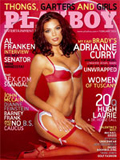 Not the day that I got my first Playboy cover,because that was pretty big, but the day I got my second Playboycover, because this was a magazine that Cindy Crawford had posed in, that huge stars have posed in. And to be in that magazine before, God forbid anything happens to Hugh Hefner, I was a part of that. And no matter what happens to me in my life, I’m going to have that and say, “I was a part of that.” I’ll be 90 years old saying, “Your grandma was smoking back in the day! Come look at these pictures, yeah!”—Especially since they came out so artistic. I was looking to accentuate the modelesque features. My second spread was all European-looking with rich French interiors and just wearing long flowing
Not the day that I got my first Playboy cover,because that was pretty big, but the day I got my second Playboycover, because this was a magazine that Cindy Crawford had posed in, that huge stars have posed in. And to be in that magazine before, God forbid anything happens to Hugh Hefner, I was a part of that. And no matter what happens to me in my life, I’m going to have that and say, “I was a part of that.” I’ll be 90 years old saying, “Your grandma was smoking back in the day! Come look at these pictures, yeah!”—Especially since they came out so artistic. I was looking to accentuate the modelesque features. My second spread was all European-looking with rich French interiors and just wearing long flowing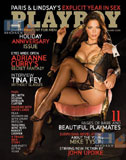 robes and lush shoes and materials. Everything was designer, and that’s what I was going for when I saw it. It was so Vogue. To work with Stephen Wayda was absolutely amazing. He totally got my vision of who I was and what I needed to portray. I wanted a story, which I got with each shoot. It was awesome.
robes and lush shoes and materials. Everything was designer, and that’s what I was going for when I saw it. It was so Vogue. To work with Stephen Wayda was absolutely amazing. He totally got my vision of who I was and what I needed to portray. I wanted a story, which I got with each shoot. It was awesome.
What about the second Playboy shoot?
The second shoot was very Helmut Newtonesque, very Stanley Kubrick Eyes Wide Shut. It was just lush and rich, voyeuristic and grand. It’s probably the best work that I’ve ever done.
What’s the most interesting shoot that you’ve done besidesPlayboy?
The most interesting shoot that I’ve done was for Merit Diamond and their Sirena collection. And we filmed underwater. For an entire night I had an oxygen tank and a regulator at the bottom of the pool with weights on my calves. I couldn’t see anything. I was under there for so long, I came up at the end of the night and I just puked all over the outside of this pool 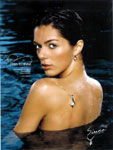 because my equilibrium was off. We had divers there instructing us what was good and what was not good for me, and they got really mad because at the end of the commercial they wanted me swimming from the bottom of the pool and bursting out of the pool. Well, the first you know about diving is you can’t do that. You have to slowly come up, equalize, I didn’t do that and that’s what got me so sick. I kept bursting out [over and over again]—I’m a mermaid . . . I puked everywhere, and everyone was so grossed out. I’m in the pool and everyone’s in wetsuits, and I asked them what did they do when they had to go to the bathroom? They all smiled [devilishly] and I was like [gross], my mouth has to be open under water! That was the craziest shoot I ever did. It was really elaborate and everything was so strange, but we did have a great time. That was in Florida about three years ago.
because my equilibrium was off. We had divers there instructing us what was good and what was not good for me, and they got really mad because at the end of the commercial they wanted me swimming from the bottom of the pool and bursting out of the pool. Well, the first you know about diving is you can’t do that. You have to slowly come up, equalize, I didn’t do that and that’s what got me so sick. I kept bursting out [over and over again]—I’m a mermaid . . . I puked everywhere, and everyone was so grossed out. I’m in the pool and everyone’s in wetsuits, and I asked them what did they do when they had to go to the bathroom? They all smiled [devilishly] and I was like [gross], my mouth has to be open under water! That was the craziest shoot I ever did. It was really elaborate and everything was so strange, but we did have a great time. That was in Florida about three years ago.
You still do a lot of modeling now?
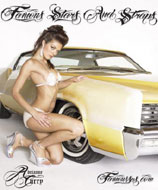 I haven’t been signed to an agency in a very long time. I only take the modeling that comes to me. I loved modeling from Travis Barker’s line, Stars and Straps, because it was so edgy and rocker.
I haven’t been signed to an agency in a very long time. I only take the modeling that comes to me. I loved modeling from Travis Barker’s line, Stars and Straps, because it was so edgy and rocker.
So you really have just moved 100% into television?
Absolutely! First of all I’m 25 years old. That’s way too old for this industry. Most models last until they’re 21 and they’re thrown away. But I’m going to do things in this industry from being who I am. As I was flipping through Fredericks of Hollywood, I thought I would like to do this. They have really cleaned up their image. They’re very Victoria Secret. I like it, but they’re edgier. They’re me. I have Frederick’s everything. I said, “Maybe I should call them.” Realistically, I’m not pin-thin anymore. I can’t do the runways in New York anymore. I tortured myself to walk the ones that I did. I hadn’t eaten in like three weeks, and I’m walking down the runway all gaunt, dying, and that’s just not for me. And it’s so great to be able to go on television, make money from that and [instead] let modeling be something that’s fun. But I’m probably going to sign with another agency soon. I like Ford. I just had a bad experience with my last one because they were angry with “Top Model” so they took it out on me. And that was ugly.
Lowest Low:
I was in Cape Town, South Africa [and got treated so badly there. They actually told me they wanted to stick it to “Top Model”] and I was stuck in this two-year contract. I ran out of money and they wouldn’t even get any of my money wired to me. I had to ask my mother, who couldn’t afford it, could I have some money. I wrote Tyra Banks, and I had asked for her advice before. She was my angel when I won “Top Model.” I saw her as a deity that saved my life and I really respected her. I loved her and I thought that she was my friend. But then the realization that it was all just TV hit me when the advice wasn’t forthcoming. I got so frustrated and angry, I wrote her hate mail. I just felt so down. My career was over. I had no money. I thought, she’s not even going to help me or even give me any advice, so I wrote . . . an angry letter. Then I went home and didn’t know what I was going to do until I heard about that show “The Surreal Life.” I saw how it had resurrected other careers. It had been one year since I won “Top Model” and I was already old news. No one cared about me. And I decided to go on the show, and things changed. But that was the lowest of the lows for me. Because I really thought it was over. In fact I had packed up, moved back home to Joliet, Illinois, and was living there for four months before I got the gig for “The Surreal Life.” I had at least traveled the world, but it took all my money.
What advice would you give to those trying to pursue their dream?
Always have a backup plan. My plan when this is all over is to go to college. Don’t let this industry destroy you, because it eats souls for a living, especially the modeling world. I remember I was running up and down subway stairs to get to castings, and I had really built up my thighs. I didn’t mean to. It just happens. They told me, “Oh my God, look how fat your thighs have gotten.” I said, “Get over here. Touch it. It’s like a rock! That’s not fat.” All they could say was I needed to lose it. So I asked them if they were going to buy me a car with a chauffeur. Otherwise, it’s not going anywhere. They’re very harsh. And you have to be a really strong person.
Visit the following websites to learn more about Adrianne Curry:www.adriannemcurry.com and www.myspace.com/adricurry.
Interviewed by Kaylene Peoples
